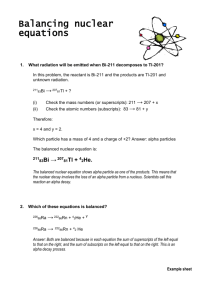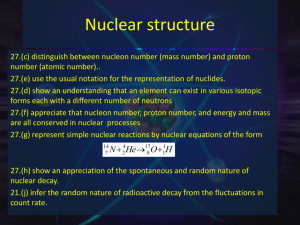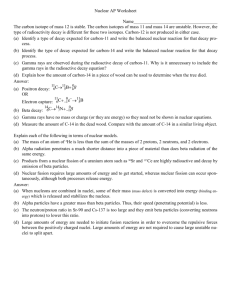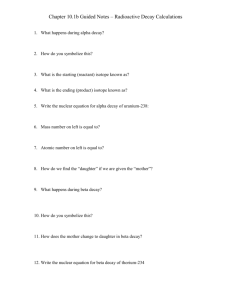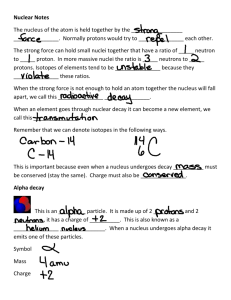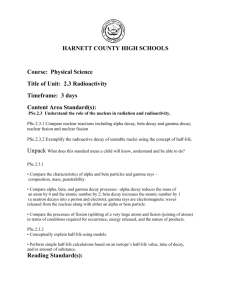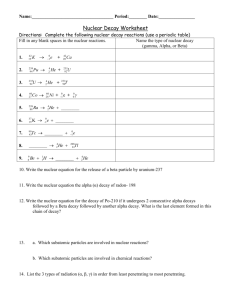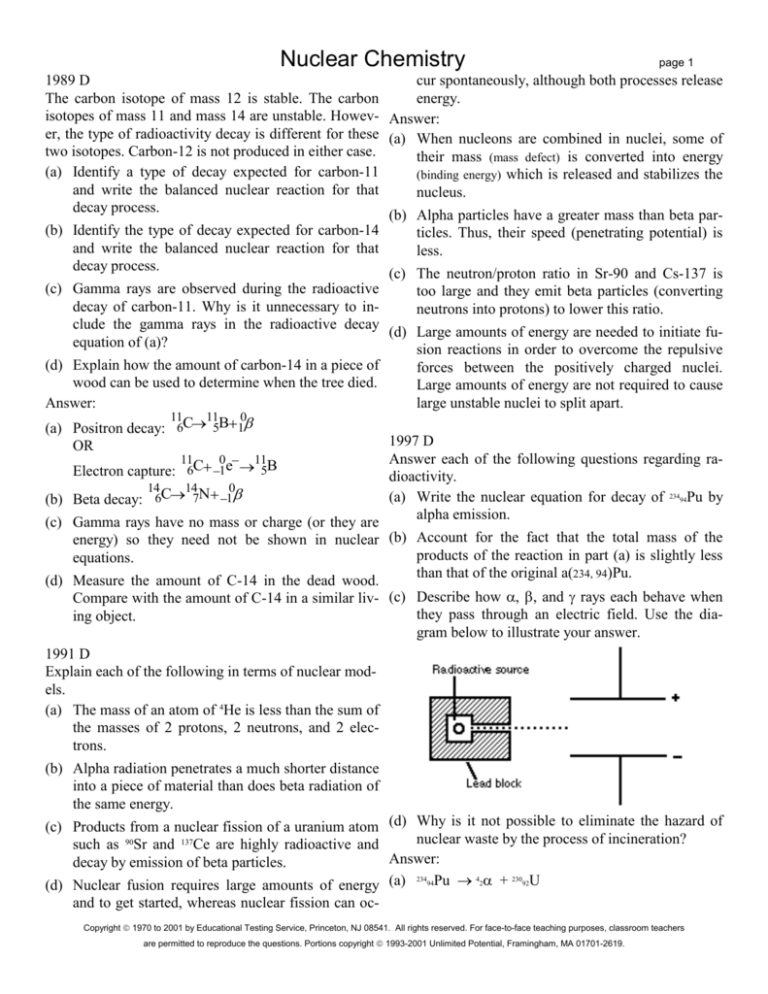
Nuclear Chemistry
page 1
1989 D
cur spontaneously, although both processes release
The carbon isotope of mass 12 is stable. The carbon
energy.
isotopes of mass 11 and mass 14 are unstable. Howev- Answer:
er, the type of radioactivity decay is different for these (a) When nucleons are combined in nuclei, some of
two isotopes. Carbon-12 is not produced in either case.
their mass (mass defect) is converted into energy
(a) Identify a type of decay expected for carbon-11
(binding energy) which is released and stabilizes the
and write the balanced nuclear reaction for that
nucleus.
decay process.
(b) Alpha particles have a greater mass than beta par(b) Identify the type of decay expected for carbon-14
ticles. Thus, their speed (penetrating potential) is
and write the balanced nuclear reaction for that
less.
decay process.
(c) The neutron/proton ratio in Sr-90 and Cs-137 is
(c) Gamma rays are observed during the radioactive
too large and they emit beta particles (converting
decay of carbon-11. Why is it unnecessary to inneutrons into protons) to lower this ratio.
clude the gamma rays in the radioactive decay
(d) Large amounts of energy are needed to initiate fuequation of (a)?
sion reactions in order to overcome the repulsive
(d) Explain how the amount of carbon-14 in a piece of
forces between the positively charged nuclei.
wood can be used to determine when the tree died.
Large amounts of energy are not required to cause
Answer:
large unstable nuclei to split apart.
11
11
0
(a) Positron decay: 6C 5B1
1997 D
OR
Answer each of the following questions regarding ra11
0 11
Electron capture: 6C1e 5B
dioactivity.
14
14
0
(a) Write the nuclear equation for decay of 23494Pu by
(b) Beta decay: 6C 7N1
alpha emission.
(c) Gamma rays have no mass or charge (or they are
energy) so they need not be shown in nuclear (b) Account for the fact that the total mass of the
products of the reaction in part (a) is slightly less
equations.
than that of the original a(234, 94)Pu.
(d) Measure the amount of C-14 in the dead wood.
Compare with the amount of C-14 in a similar liv- (c) Describe how , , and rays each behave when
they pass through an electric field. Use the diaing object.
gram below to illustrate your answer.
1991 D
Explain each of the following in terms of nuclear models.
(a) The mass of an atom of 4He is less than the sum of
the masses of 2 protons, 2 neutrons, and 2 electrons.
(b) Alpha radiation penetrates a much shorter distance
into a piece of material than does beta radiation of
the same energy.
(c) Products from a nuclear fission of a uranium atom (d) Why is it not possible to eliminate the hazard of
nuclear waste by the process of incineration?
such as 90Sr and 137Ce are highly radioactive and
Answer:
decay by emission of beta particles.
234
4
230
(d) Nuclear fusion requires large amounts of energy (a) 94Pu 2 + 92U
and to get started, whereas nuclear fission can ocCopyright 1970 to 2001 by Educational Testing Service, Princeton, NJ 08541. All rights reserved. For face-to-face teaching purposes, classroom teachers
are permitted to reproduce the questions. Portions copyright 1993-2001 Unlimited Potential, Framingham, MA 01701-2619.
Nuclear Chemistry
page 2
Due to a printing error, the student’s answer booklet had the Pu239 isotope. Therefore, the following is a valid response.
239
Pu 42 + 23592U
94
(b) This mass defect has been converted into energy.
E = mc2
(c) An alpha particle, or He nuclei, has a 2+ charge
and would be attracted to the (-) side of the electric field. A beta particle, , or electron, has a single negative charge and is attracted to the positive
side of the electric field, but since it is much light- (d) The half-life of a radionuclide is independent of
its environment. Incineration will neither accelerer and faster than an alpha it would not be as
ate its decay nor render it non-radioactive. Halfstrongly deflected. Gamma, , rays are not charged
life is a function of its nucleus, incineration is a
and, therefore, not deflected by the electric field.
function of its electrons.
Copyright 1970 to 2001 by Educational Testing Service, Princeton, NJ 08541. All rights reserved. For face-to-face teaching purposes, classroom teachers
are permitted to reproduce the questions. Portions copyright 1993-2001 Unlimited Potential, Framingham, MA 01701-2619.


